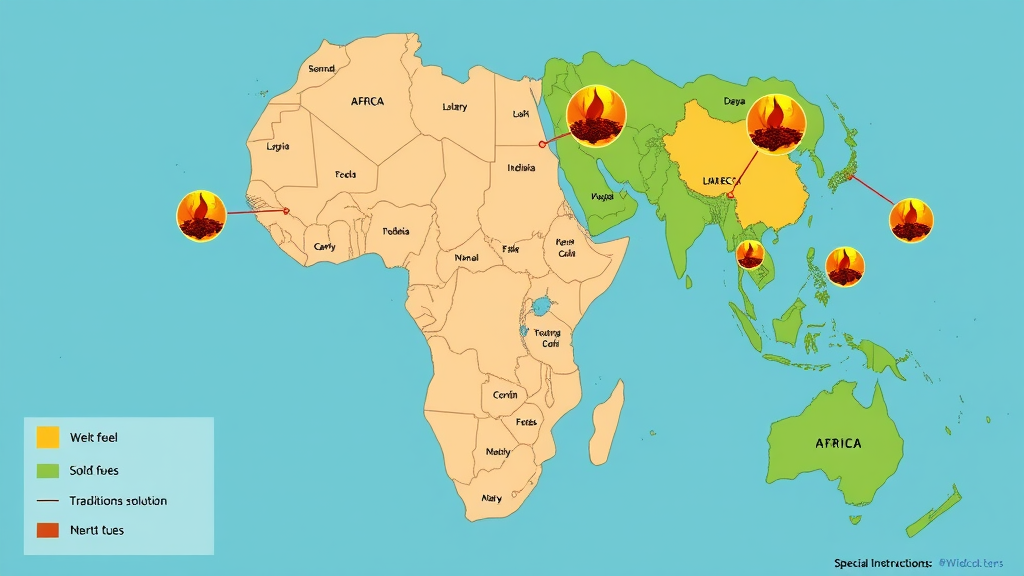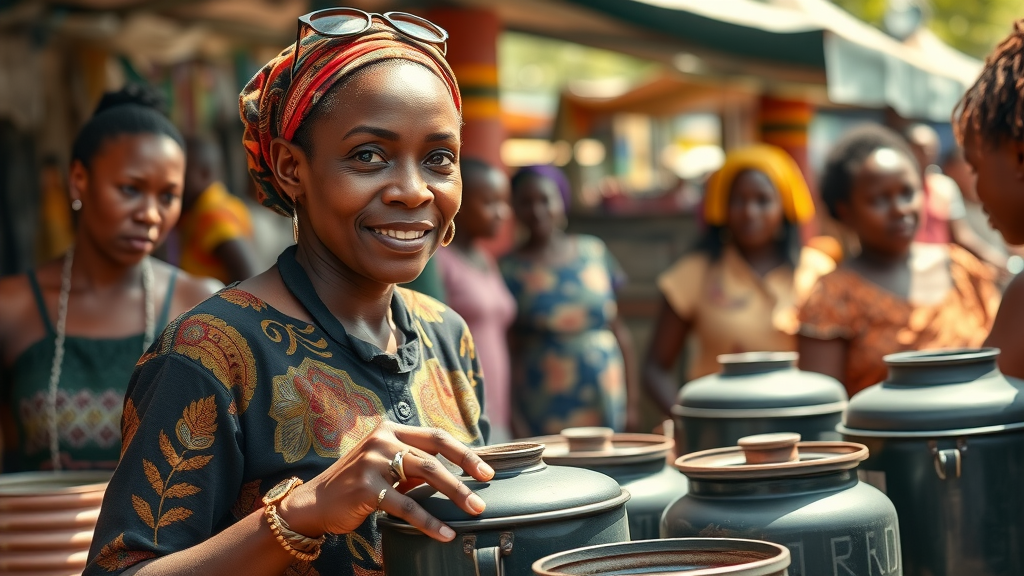Did you know that over 900 million Africans still rely on traditional, solid fuels for cooking, leading to 600,000 premature deaths every year from indoor air pollution ? The problem is urgent, yet overlooked. Clean cooking technology doesn’t just cut down on smoke, it is a lifeline, preserving families, empowering women, and defending precious forests. In this article, we'll dive deep into how clean cooking technology is saving lives and fuel in African communities, here’s how innovation and determination can shape a safer, healthier future for millions.
-
Did you know that over 900 million Africans still rely on traditional, solid fuels for cooking, contributing to 600,000 premature deaths each year from indoor air pollution? Unpacking this startling reality, clean cooking technology is more than a convenience, it’s a transformative life-saving revolution. This article reveals how embracing clean cooking solutions is not just an environmental imperative, but a human rights necessity for the continent.

A Wake-Up Call: Why Clean Cooking Technology is Saving Lives and Fuel in African Communities, Here’s How
-
The tangible health benefits of clean cooking
-
Economic and environmental impacts of clean cooking solutions
-
Real-life stories from African communities transformed by cooking solutions
-
Implications for climate change and fuel savings
-
Practical policy recommendations for scaling clean cooking access
What Clean Cooking Technology is Saving Lives and Fuel in African Communities, Here’s How Will Reveal
Clean cooking technology is saving lives and fuel in African communities, here’s how: by tackling household air pollution, slashing the need for time-consuming wood collection, and opening doors to improved quality of life. In this section, you'll learn how replacing traditional open fires or basic stoves with modern clean cookstoves and fuels delivers massive change. With cleaner fuels and safer stoves, families spend less time collecting wood and more time focusing on health, education, and economic opportunity. The adoption of clean cooking solutions is a turning point for gender equality, climate change mitigation, and long-term sustainability.
The reality is clear: without urgent access to clean cooking, over 80% of sub-Saharan Africans remain at risk from dangerous indoor air, fuel poverty, and deforestation. As we move through this article, you’ll see how clean cook technology achieves far more than just convenience, it’s a proven strategy for addressing premature death, stimulating local economies, and building resilient communities.
Understanding the Clean Cooking Challenge Across Africa
Widespread Reliance on Dirty Cooking Fuels
In much of Africa, traditional cooking is still dominated by open fire methods and the use of solid fuels such as wood, charcoal, and agricultural residues. Approximately 900 million people across the continent cook their meals over these basic stoves or open fires. The regional disparities are stark : in rural areas, reliance on firewood approaches 90%, while even in urban centers, charcoal use remains widespread. Africa’s rapid population growth compounds the issue, driving up demand for firewood and further depleting local forests. The lack of universal access to clean cooking stoves and fuels means millions are trapped in a cycle of time poverty and health risks, a far cry from the simple convenience many outside the continent might associate with meal preparation.
The urgent need for clean cooking solutions cannot be overstated. The contrast between areas adopting clean cookstove initiatives and those still reliant on traditional fuels is evident, in health outcomes, household economics, and environmental preservation. Yet, despite growing awareness and innovation, clean cooking access remains a formidable challenge for policymakers and communities alike.

Obstacles to Access to Clean Cooking Technology
Socioeconomic status often dictates a household’s ability to convert to clean cook technology. Many African families struggle to afford even the initial investment for a clean cookstove, let alone the ongoing cost of cleaner fuels such as LPG or biogas. Markets for clean cooking solutions remain underdeveloped in some regions, and public awareness around the health dangers of traditional cooking is still limited. On top of that, the lack of infrastructure, such as reliable electricity access or distribution networks for clean fuels, makes scaling clean cooking technologies even more difficult.
Policy gaps are another barrier. While several African governments have established goals for universal access to clean cooking by 2030, progress lags due to constrained budgets, limited data, and challenges in coordinating between the public and private sector . The result is that millions remain reliant on old cooking methods, subject to daily indoor air pollution, and exposed to preventable health and safety risks. For clean cooking technology to become the norm, integrated solutions, combining policy, financing, and community engagement—must be fast-tracked across the continent.
The Health Impact: Clean Cooking Technology is Saving Lives and Fuel in African Communities, Here’s How
How Clean Cooking Solutions Prevent Premature Death
Traditional cooking practices in Africa are a silent threat, releasing toxic smoke and particulate matter that make indoor air quality sometimes deadlier than outdoor air pollution. Children and women, who often spend several hours a day near the hearth, are the most susceptible. The direct result: respiratory diseases, chronic ailments, and tragically, a high incidence of premature death. The World Health Organization estimates 600,000 Africans die annually from complications linked to household air pollution. By adopting clean cookstoves and safer fuels, these communities slash exposure to deadly pollutants, significantly reducing hospital visits and millions of dollars in lost productivity.
Clean cooking technology does not just minimize premature deaths , it transforms community health from the ground up. With cleaner indoor air, families are less exposed to harmful carbon monoxide and fine particulates that lead to asthma, pneumonia, lung cancer, and cardiovascular diseases. This impact is visible not just in numbers, but in the stories of households who can finally breathe easy thanks to a simple switch.
Improving Indoor Air With Clean Cooking Access
The benefits of clean cooking access are especially profound for women and children . In many communities, women and girls bear the brunt of household labor, spending endless hours exposed to smoke emanating from open fires. Children, often carried on mothers’ backs during cooking—inhale dangerous fumes with lifelong consequences. Providing clean cooking solutions significantly improves the quality of indoor air. The reduction in air contaminants leads to visible, qualitative improvements in health: fewer cases of coughing, wheezing, and severe respiratory infections; more energy for play and learning; and less time lost to illness.
This transformation does not go unnoticed. As one health worker put it, “Switching to clean cook stoves is as important as vaccines or safe drinking water for millions of African families.” The ripple effect of healthier families includes enhanced educational outcomes, a more productive workforce, and savings in healthcare costs that can be redirected towards strengthening communities.
“Switching to clean cook stoves is as important as vaccines or safe drinking water for millions of African families.”

Economic Benefits: How Clean Cooking Technology is Saving Lives and Fuel in African Communities, Here’s How
Fuel Savings and Household Economics
The economic case for clean cooking technology is just as compelling as the health case. Traditional cooking methods require families to spend hours each week gathering firewood or spending hard-earned cash on charcoal and inefficient fuels. According to field studies, the time women and children save from switching to efficient stoves often amounts to thousands of hours a year , time that can be used for education, small businesses, or leisure. Clean cooking solutions drastically lower household spending on fuel and reduce health-related absenteeism and costs.
The financial implications go even further. With fewer resources spent on wood or charcoal, families are able to reallocate savings towards food, school fees, or medical treatment. Community cooperatives centered around clean cook technology also stimulate local job creation, from sales agents to technicians. As adoption grows, the clean cook market flourishes, creating ‘green’ entrepreneurship opportunities that further amplify household prosperity. 🔗 Visit Smart Kitchen Solutions Uganda to learn more or order your eco-stove today.

Empowering Women Through Clean Cooking Access
Access to clean cook technology is a profound lever for women’s empowerment . Traditional cooking burdens women and girls, limiting educational attainment and income-generating activities. By introducing clean cooking solutions, women gain time and health, better positioning them to engage in business, agriculture, and civic leadership. Research confirms that when women are free from hours spent collecting wood and dealing with illness from air pollution, their entire household benefits.
Moreover, clean cook markets offer unique opportunities for women as micro-entrepreneurs, allowing them to sell or maintain efficient stoves and clean fuels within their communities. Empowering women in this way fosters more equitable development, narrows the gender gap, and supports the goal of universal access to clean cooking for all.
|
|
|
Traditional vs Clean Cooking: A Real-World Comparison |
|
Category |
Traditional Cooking |
Clean Cooking Solutions |
|---|---|---|
|
Health |
High risk of indoor air pollution, respiratory diseases, premature deaths |
Dramatically lower household air pollution, improved health, fewer deaths |
|
Cost |
Expense for fuel collection/purchase, medical bills, lost wages |
Lower operating costs, more savings, less healthcare spending |
|
Time |
Hours per day spent gathering fuel |
Time freed for education, work, and family |
|
Fuel Use |
High consumption of wood/charcoal, deforestation |
Efficient use of LPG, ethanol, biogas, or solar |
Environmental Impact: Clean Cooking Technology is Saving Lives and Fuel in African Communities—Here’s How
Less Greenhouse Gas Emissions from Clean Cooking Solutions
The adoption of clean cooking technology is a vital tool in the fight against climate change. Traditional stoves and open fires are major sources of greenhouse gas emissions, including methane and black carbon. When millions of families switch to efficient stoves or clean fuels, the reduction in emissions is significant—helping local air quality and contributing globally toward climate goals. Clean cooking solutions thus form a ‘double dividend’ by protecting both community health and the planet.
Beyond just regional benefits, the collective shift away from wood and charcoal fuels reduces Africa’s carbon footprint and creates lasting positive impacts on cloud formation, rainfall patterns, and biodiversity. By deploying market-driven, scalable clean cook innovations, countries can hit several Sustainable Development Goals at once, especially those related to health, gender, and environmental sustainability.
Mitigating Deforestation with Clean Cooking Access
Deforestation is often driven by demand for firewood and charcoal used for cooking. Switching to fuel-efficient or alternative energy-based clean cook solutions slows the depletion of forests, allowing trees to regenerate and providing valuable ecosystem services. Community-based projects that couple clean cook technology with reforestation efforts are now springing up across Africa, increasing resilience to climate shocks and sustaining local biodiversity.
These initiatives not only relieve immediate pressure on woodlands but also help reshape the human relationship with the environment, showing that clean energy and ecological stewardship can advance together. As more African communities experience the benefits, local attitudes are shifting from viewing trees as disposable fuel sources to seeing them as vital partners in a sustainable future.

Transformative Stories: Clean Cooking Technology is Saving Lives and Fuel in African Communities—Here’s How
Real Experiences with Clean Cooking Solutions
From urban slums in Nigeria to rural villages in Kenya and Ghana, families are experiencing a new sense of safety and hope thanks to clean cooking solutions. In one village, women describe the peace of mind they gained—and the persistent coughs that vanished—after community leaders worked with NGOs to distribute efficient cookstoves. Another story highlights a cooperative of women entrepreneurs who are building livelihoods selling and maintaining clean cooking technology, while also serving as role models for healthier, safer kitchens.
Community leaders report stronger school attendance now that children spend less time sick or gathering fuel. Local clinics observe fewer respiratory emergencies, and neighborhood savings groups are able to invest in new ventures. Each story carries a similar theme: the transition to clean cooking unlocks opportunities, restores dignity, and builds resilience. These aren’t just anecdotes—they’re blueprints for policy and program design moving forward.

Frequently Asked Questions on Clean Cooking Technology is Saving Lives and Fuel in African Communities—Here’s How
What is access to clean fuels and technologies for cooking?
Access to clean fuels and technologies for cooking means that households utilize energy sources and appliances that meet recommended guidelines for air quality—minimizing health and environmental risks, as defined by the World Health Organization.
What percentage of people in Africa rely on solid fuel for cooking?
Over 80% of sub-Saharan Africa’s population depends on solid fuels like wood, charcoal, or crop residue for daily cooking. This reliance contributes to severe air pollution, environmental degradation, and limited opportunities for improvement in household well-being.
What is clean fuel for cooking?
Clean fuel for cooking includes modern energy sources such as liquefied petroleum gas (LPG), ethanol, biogas, electricity, and solar power. These fuels burn efficiently and produce little or no harmful emissions, reducing risks to people and the environment.
What percentage of the world's population does not have access to clean fuels for cooking?
Nearly 2.4 billion people worldwide—over 30% of the global population—lack regular access to clean fuels and technologies for cooking. This immense gap perpetuates cycles of poverty, illness, and environmental damage, particularly in the world’s poorest regions.
Overcoming Challenges to Provide Clean Cooking Solutions in African Communities
Policy Pathways toward Universal Clean Cooking Access
Achieving universal access to clean cooking requires targeted government action, smart subsidies, and innovative financing. Governments need to create clear standards for clean cook solutions, subsidize first-time purchases, and support rural distribution networks. International NGOs and foundations play a crucial role by piloting scalable interventions and championing clean cooking initiatives at global forums. The private sector, meanwhile, can foster market-based growth, from manufacturing to local entrepreneurship.
For long-term impact, policies must align national development priorities with global sustainability targets, such as the UN’s Sustainable Development Goals. Collaboration between energy ministries, health departments, and education sectors can help accelerate adoption and ensure that solutions are accessible, affordable, and culturally accepted.
Innovations in Clean Cooking Technology
The past decade has seen a wave of innovations in clean cook technology, ranging from fuel-efficient stoves designed for local tastes, to pay-as-you-cook smart meters, and affordable solar-powered devices. These advances improve efficiency, decrease emissions, and lower operational costs. Social enterprises are integrating these new devices into rural markets with micro-lending and community-based financing.
Tailoring technology to local conditions and employing women as entrepreneurs and technicians have proven especially effective. The future of clean cooking solutions in Africa rests on innovations that are scalable, adaptable, and able to enhance, not disrupt, traditional cooking practices.
Key Reasons Clean Cooking Technology is Saving Lives and Fuel in African Communities, Here’s How
-
Massive reduction in premature deaths
-
Economic and time savings for households
-
Women’s empowerment
-
Lower climate change risks
-
Sustainable development for future generations
Take Action: Support the Expansion of Clean Cooking Technology in Africa
-
Engage your networks—talk about the impact of clean cooking solutions and why they matter.
-
Support local and international clean cook initiatives through donations or volunteering.
-
Advocate for policy change among decision-makers—request stronger commitments and funding for universal clean cooking access.
-
Help bring clean cooking solution to every African home by raising awareness and supporting entrepreneurs working in this field.
Watch: How Clean Cooking Technology is Saving Lives and Fuel in African Communities
-
Embed a video testimonial from an African family or NGO showcasing transformation through clean cooking solutions.
Expert Panel: Insights on Clean Cooking Technology and Community Impact
-
Embed a roundtable video with health experts, environmental scientists, and policymakers on clean cooking access barriers and solutions.
Take the first step—champion clean cooking technology and become part of the movement saving lives and fuel across African communities today.
Clean cooking technology is revolutionizing lives across African communities by addressing critical health and environmental challenges. The International Energy Agency (IEA) emphasizes the urgency of expanding access to clean cooking solutions in sub-Saharan Africa, where traditional cooking methods contribute to significant health risks and environmental degradation. ( axios.com ) Innovative enterprises like Burn Manufacturing in Kenya are leading the charge by producing affordable electric cookstoves, reducing reliance on wood and charcoal, and thereby mitigating deforestation and greenhouse gas emissions. ( time.com ) These initiatives not only improve health outcomes by reducing indoor air pollution but also empower women and promote sustainable development. If you’re committed to fostering healthier communities and protecting the environment, exploring these resources will provide valuable insights into the transformative impact of clean cooking technologies in Africa.
 Add Row
Add Row  Add
Add 




Write A Comment